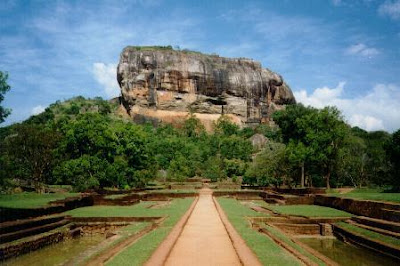36. Banaue Rice Terraces, Philippines
The Banaue Rice Terraces are 2000-year old terraces that were carved into the mountains of Ifugao in the Philippines by ancestors of the indigenous people. The Rice Terraces are commonly referred to by Filipinos as the "Eighth Wonder of the World". It is commonly thought that the terraces were built with minimal equipment, largely by hand. The terraces are located approximately 1500 meters (5000 ft) above sea level and cover 10,360 square kilometers (about 4000 square miles) of mountainside. They are fed by an ancient irrigation system from the rainforests above the terraces. It is said that if the steps are put end to end it would encircle half the globe.
37. Kremlin, Russia
The Moscow Kremlin is a historic fortified complex at the heart of Moscow, overlooking the Moskva River (to the south), Saint Basil's Cathedral and Red Square (to the east) and the Alexander Garden (to the west). It is the best known of kremlins (Russian citadels) and includes four palaces, four cathedrals and the enclosing Kremlin Wall with Kremlin towers. The complex serves as the official residence of the President of the Russian Federation.
38. Gian't Causeway, Northern Ireland
The Giant's Causeway is an area of about 40,000 interlocking basalt columns, the result of an ancient volcanic eruption. It is located in County Antrim on the northeast coast of Northern Ireland, about three miles (4.8 km) northeast of the town of Bushmills. It was declared a World Heritage Site by UNESCO in 1986, and a National Nature Reserve in 1987 by the Department of the Environment for Northern Ireland.
39. Sydney Opera House, Australia
The Sydney Opera House is a multi-venue performing arts centre in the Australian city of Sydney. It was conceived and largely built by Danish architect Jørn Utzon, finally opening in 1973 after a long gestation starting with his competition-winning design in 1957. Utzon received the Pritzker Prize, architecture's highest honour, in 2003.
40. Houses of Parliament & Big Ben, United Kingdom
Big Ben is the nickname for the great bell of the clock at the north end of the Palace of Westminster in London and is generally extended to refer to the clock or the clock tower as well. Some believe this extension to be incorrect, but its usage is now entirely commonplace. It is the largest four-faced chiming clock and the third-tallest free-standing clock tower in the world. It celebrated its 150th anniversary in May 2009, during which celebratory events took place. The clock was finished being built on April 10, 1858. The clock tower has become one of the most prominent symbols of both London and England, often in the establishing shot of films set in the city.
41. Boracay Island, Philippines
Boracay is an island of the Philippines located approximately 315 km (200 miles) south of Manila and 2 km off the northwest tip of Panay Island in the Western Visayas region of the Philippines. In 1990, it was voted by the BMW Tropical Beach Handbook as one of the best beaches in the world and again in 1996 by British publication TV Quick as the world's number one tropical beach.
42. Ganges River, India
The Ganges is a trans-boundary river of India and Bangladesh. The 2,525 km (1,569 mi) river rises in the western Himalayas in the Indian state of Uttarakhand, and flows south and east through the Gangetic Plain of North India into Bangladesh, where it empties into the Bay of Bengal. By discharge it ranks among the world's top 20 rivers. The Ganges basin is the most heavily populated river basin in the world, with over 400 million people and a population density of about 1,000 inhabitants per square mile (390 /km2).
43. Ganadian Rockies, Canada
The Canadian Rockies have numerous high peaks and ranges, such as Mount Robson (3,954 metres (12,972 ft)) and Mount Columbia (3,747 metres (12,293 ft)). The Canadian Rockies are composed of shale and limestone (unlike their American cousins). Much of the range is protected by parks and a World Heritage Site.
44. Mount Fuji, Japan
Mount Fuji is the highest mountain in Japan at 3,776.24 m (12,389 ft). An active stratovolcano that last erupted in 1707–08, Mount Fuji lies about 100 kilometres (60 miles) south-west of Tokyo, and can be seen from there on a clear day. Mount Fuji's exceptionally symmetrical cone is a well-known symbol of Japan and it is frequently depicted in art and photographs, as well as visited by sightseers and climbers. It is one of Japan's "Three Holy Mountains" along with Mount Tate and Mount Haku.
45. The Moal Statues of Easter Island, Chile
Moai are monolithic human figures carved from rock on the Polynesian island of Easter Island between the years 1250 and 1500. Nearly half are still at Rano Raraku, the main moai quarry, but hundreds were transported from there and set on stone platforms called ahu around the island's perimeter. Almost all moai have overly large heads three-fifths the size of their bodies. The moai are chiefly the living faces (aringa ora) of deified ancestors (aringa ora ata tepuna). The statues still gazed inland across their clan lands when Europeans first visited the island, but most would be cast down during later conflicts between clans.













































